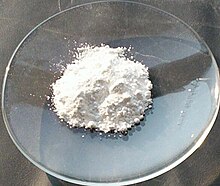
| |
| Names | |
|---|---|
| Other names
Zinc white, calamine, philosopher's wool, Chinese white, flowers of zinc
| |
| Identifiers | |
3D model (JSmol)
|
|
| ChEBI | |
| ChEMBL | |
| ChemSpider | |
| DrugBank | |
| ECHA InfoCard | 100.013.839 |
| EC Number |
|
| 13738 | |
| KEGG | |
PubChem CID
|
|
| RTECS number |
|
| UNII | |
| UN number | 3077 |
CompTox Dashboard (EPA)
|
|
| |
| |
| Properties | |
| ZnO | |
| Molar mass | 81.406 g/mol[1] |
| Appearance | White solid[1] |
| Odor | Odorless |
| Density | 5.6 g/cm3[1] |
| Melting point | 1,974 °C (3,585 °F; 2,247 K) (decomposes)[1][7] |
| Boiling point | 2,360 °C (4,280 °F; 2,630 K) (decomposes) |
| 0.0004% (17.8°C)[2] | |
| Band gap | 3.2 eV (direct)[3] |
| Electron mobility | 180 cm2/(V·s)[3] |
| −27.2·10−6 cm3/mol[4] | |
| Thermal conductivity | 0.6 W/(cm·K)[5] |
Refractive index (nD)
|
n1=2.013, n2=2.029[6] |
| Structure[8] | |
| Wurtzite | |
| C6v4-P63mc | |
a = 3.2495 Å, c = 5.2069 Å
| |
Formula units (Z)
|
2 |
| Tetrahedral | |
| Thermochemistry[9] | |
Heat capacity (C)
|
40.3 J·K−1mol−1 |
Std molar
entropy (S⦵298) |
43.65±0.40 J·K−1mol−1 |
Std enthalpy of
formation (ΔfH⦵298) |
-350.46±0.27 kJ mol−1 |
Gibbs free energy (ΔfG⦵)
|
-320.5 kJ mol−1 |
Enthalpy of fusion (ΔfH⦵fus)
|
70 kJ/mol |
| Pharmacology | |
| QA07XA91 (WHO) | |
| Hazards | |
| GHS labelling: | |

| |
| Warning | |
| H400, H401 | |
| P273, P391, P501 | |
| NFPA 704 (fire diamond) | |
| Flash point | 1,436 °C (2,617 °F; 1,709 K) |
| Lethal dose or concentration (LD, LC): | |
LD50 (median dose)
|
240 mg/kg (intraperitoneal, rat)[10] 7950 mg/kg (rat, oral)[11] |
LC50 (median concentration)
|
2500 mg/m3 (mouse)[11] |
LCLo (lowest published)
|
2500 mg/m3 (guinea pig, 3–4 h)[11] |
| NIOSH (US health exposure limits): | |
PEL (Permissible)
|
TWA 5 mg/m3 (fume) TWA 15 mg/m3 (total dust) TWA 5 mg/m3 (resp dust)[2] |
REL (Recommended)
|
Dust: TWA 5 mg/m3 C 15 mg/m3 Fume: TWA 5 mg/m3 ST 10 mg/m3[2] |
IDLH (Immediate danger)
|
500 mg/m3[2] |
| Safety data sheet (SDS) | ICSC 0208 |
| Related compounds | |
Other anions
|
Zinc sulfide Zinc selenide Zinc telluride |
Other cations
|
Cadmium oxide Mercury(II) oxide |
Except where otherwise noted, data are given for materials in their standard state (at 25 °C [77 °F], 100 kPa).
| |
Zinc oxide is an inorganic compound with the formula ZnO. It is a white powder which is insoluble in water. ZnO is used as an additive in numerous materials and products including cosmetics, food supplements, rubbers, plastics, ceramics, glass, cement, lubricants,[12] paints, sunscreens, ointments, adhesives, sealants, pigments, foods, batteries, ferrites, fire retardants, semi conductors,[13] and first-aid tapes. Although it occurs naturally as the mineral zincite, most zinc oxide is produced synthetically.[14]
- ^ a b c d Haynes, pp. 4.95, 12.80
- ^ a b c d NIOSH Pocket Guide to Chemical Hazards. "#0675". National Institute for Occupational Safety and Health (NIOSH).
- ^ a b Haynes, pp. 12.85, 12.89
- ^ Haynes, p. 4.131
- ^ Haynes, p. 12.80
- ^ Haynes, pp. 4.138, 10.251
- ^ Cite error: The named reference
meltwas invoked but never defined (see the help page). - ^ Haynes, p. 4.145
- ^ Haynes, pp. 5.2, 5.42, 6.163
- ^ Zinc oxide. Chem.sis.nlm.nih.gov. Retrieved on 2015-11-17.
- ^ a b c "Zinc oxide". Immediately Dangerous to Life or Health Concentrations (IDLH). National Institute for Occupational Safety and Health (NIOSH).
- ^ Cite error: The named reference
wearwas invoked but never defined (see the help page). - ^ Özgür Ü, Alivov YI, Liu C, Teke A, Reshchikov M, Doğan S, Avrutin VC, Cho SJ, Morkoç AH (2005). "A comprehensive review of ZnO materials and devices". Journal of Applied Physics. 98 (4): 041301–041301–103. Bibcode:2005JAP....98d1301O. doi:10.1063/1.1992666.
- ^ De Liedekerke M (2006). "2.3. Zinc Oxide (Zinc White): Pigments, Inorganic, 1". Ullmann's Encyclopedia of Industrial Chemistry. Weinheim: Wiley-VCH. doi:10.1002/14356007.a20_243.pub2.
